Wednesday, February 28, 2007
Rape of the Sab...sab...zzzzzz
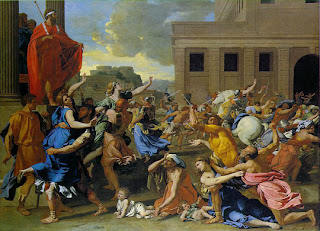
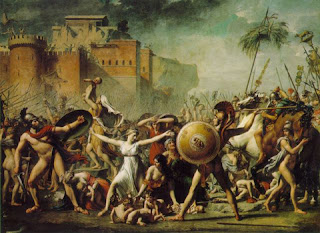
The Triple Diesel posse brushed off the dust of the Art Fair Weekend and made it to the sold-out screening of Eve Sussman/Rufus Corporation's "Rape of the Sabine Women" or "The Rape of Europa" as an old lady in line called it.
The video unfolds with gravitas and grandeur. No actor speaks nor smiles. All move slowly or in slow-motion, or both. Sound effects splice with the soundtrack, which is primarily percussive, beginning with the coughs dominating the first two or three hours of the video. This segment (1) is set in the Pergamon Museum in Berlin. Extras from "The Matrix" amble between sculptures and their visual presence is welcome after the lengthy, aforementioned chatter of disembodied coughs, which possibly, cynically signify "the dustbin" of history, which is archived in an archaeologically-inclined venue such as the Pergamon. Via Sussman, the museum's visitors, all male, dressed alike, anonymous, echo the museum's preserves: objects made by interchangeable males carrying out the monotonous drudgery of building art history.
This position becomes more insistent as suited men fill up an airport in segment (2), checking their watches (like we were), noting the passage of centuries of repetition. It's more likely that she's commenting on the French Academy, and not on the Pergamon itself. And although she has a point - French Academic painting was patricarchical and occasionally monotonous - the criss-crossing trajectories of art history are thrilling, stimulating, and informative. At least to us. But maybe we're being hostile and paranoid; it's possibly that she is simply taking us back into history and trying to generate a context while also setting up her narrative. If that's the case, then we're impressed by this multi-tasking.
The next segment (3) is at the Scope Art Fair: crowded, noisy, and filled with peripheral shouting in foreign languages. Women get abducted here, presumably by DIVA Fair staff desperate to increase attendance - by any means necessary.
But seriously, the key here is a spontaneous, mutually agreeable, hot make-out scene in a kitchen, which contrasts the impending violent, forced rape scene soon to follow. When it happens, though, it doesn't convey the terror and brutality of rape, as seen in Bergman's "The Virgin Spring," Noe's "Irreversible," or Kaye's "American History X." It's more like a "theoretical" rape, sort of choreographed and artificial.
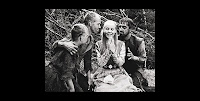
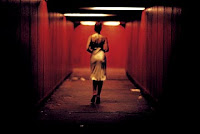
Next, we're deposited at a Greek, modernist cottage in segment (4) that looks like one of Hockney's L.A. villas. Women in brightly-colored dresses lay around, occasionally stand up and look at something, or shift in their seats. The Matrix men return and do the same thing. Some of them smoke or drink brandy. This "party" is slow but tense and potentially fun but actually an unprecedented drag. An uptight Eurotrash collector whispers to his girlfriend, only to be interrupted by a younger, peppier collector. These three continue throughout the night, flirting and probably taking turns outwitting each other. Everyone else slowly gets drunk and dances. We think of the party scenes in Anderson's "Boogie Nights" and appreciate them for their love triangles, hierarchies, and shifts, or in the proto-party masterpiece "Rules of the Game," both films far richer and more engaging. In our opinion.
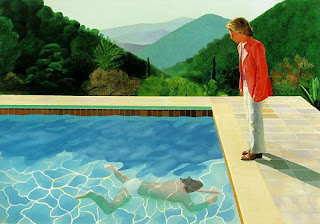
Sussman takes us "into the machine" and tours us "behind the scenes" through the set, the crew, preparations for a shoot, the actors milling around, herself calling the shots, the dressing rooms, the laundry facilities, and the fucking piece of spinach on some gaffer's tooth. This is a way of "revealing the process" and calling attention to the means and not just the end. Which, though painful, is actually pretty interesting, because for Poussin or David to make their respective paintings, lots of studies and preparation are conditions to the production of a masterpiece. But why not just let a boom drift into the scene, or maybe have a P.A. walk in front of the camera? Why drag us through the 4 or 5 hours that this felt like? Should we cook dinner after this or are we better just picking up something from Taco Bell? Also, didn't that lady over there model for our drawing class one time?
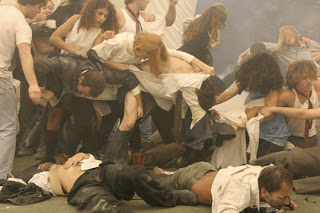
Finally, FINALLY, we're in an amphitheatre where "the Romans" and "the Sabines" are squaring off to fight. We still prefer the Jets vs. Sharks in "West Side Story" or the Greasers and Socials in "The Outsiders" or the Mods vs. Rockers in "Quadrophenia" or anyone in "The Warriors." The battle is more like a moshpit, set to screaming siren women. The Sabine women intervene in their 60's drag and all we think about are the B-52s on the Rock Lobster sleeve. Here, we get the giggles. Giggles continue as more and more perky breasts slips out of the 60s dresses. Dust is back in the air, the snake eats its tail, the museum guys cough.
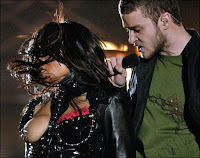
Thursday, February 22, 2007
20 years ago
Twenty years ago today, Andy Warhol died. God, it makes us crazy to wonder what he would have done with 20 more years. A new body of work? A clothing line? Likely. Web magazine? Surely. Reality TV? Of course. Blog?
Or was he already too decadent to foster any creative drive? Maybe he would have just churned out society portraits till everyone got tired of it. Warhol, the famous, artist-turned socialite. A boulevardier posing for tabloids and gawker, clutching a puppy and surrounded by wide-eyed boys. But the wrinkles and decrepit hobble would be so unglamorous - he couldn't pull off the "weathered" look like Clint Eastwood. Of course, he'd get work done - as he did for his nose.
What about AIDs? Would he have continued to steer clear?
Would he be as famous alive as he is dead? No way. At any time, t, in the world, w, a Warhol exhibition is happening: t(w) = warhol is everywhere
What would he have said about:
9/11
Kurt Cobain
The Strokes
Ecstasy
Bjork
Damien Hirst
Cecily Brown
Hedwig and the Angry Inch
Monica Lewinsky
Rodney King
Forrest Gump
Crash
Princess Di
Lost in Translation
Red Bull
Rudy Giuliani
MySpace
Deitch Projects
Mary Kate and Ashley Olsen
Dash Snow
Jason Rhoades
Or was he already too decadent to foster any creative drive? Maybe he would have just churned out society portraits till everyone got tired of it. Warhol, the famous, artist-turned socialite. A boulevardier posing for tabloids and gawker, clutching a puppy and surrounded by wide-eyed boys. But the wrinkles and decrepit hobble would be so unglamorous - he couldn't pull off the "weathered" look like Clint Eastwood. Of course, he'd get work done - as he did for his nose.
What about AIDs? Would he have continued to steer clear?
Would he be as famous alive as he is dead? No way. At any time, t, in the world, w, a Warhol exhibition is happening: t(w) = warhol is everywhere
What would he have said about:
9/11
Kurt Cobain
The Strokes
Ecstasy
Bjork
Damien Hirst
Cecily Brown
Hedwig and the Angry Inch
Monica Lewinsky
Rodney King
Forrest Gump
Crash
Princess Di
Lost in Translation
Red Bull
Rudy Giuliani
MySpace
Deitch Projects
Mary Kate and Ashley Olsen
Dash Snow
Jason Rhoades
Monday, February 19, 2007
Atkins' Art kits
The Triple Diesel posse checked out Wayne Atkins' paintings at Taxter & Spengemann. This is Atkins' second show at the gallery; we missed the first one; anyway, seems exhibiting has not distracted him from his MFA studies at CalArts. Anyway, we hear Yale was your grandpa's MFA program and Columbia your parents, but CalArts is the new "it" school because California is the new New York.
For pictures, you have to go to the gallery's web site.
Wayne Atkins' send-ups of art history are as hilarious as they are clever. Each painting depicts existing, famous works of art, and depicts them in galleries loosely governed by perspective, proscenium format. So each painting is a miniature gallery.
Also, Atkins' vocabulary is that of art history. His paintings, if essays, would be filled with footnotes, asterisks, and ibids.
Lots of people make art about art. Amy Wilson recently showed watercolors at Bellwether gallery, for example, combining famous art objects, viewers, and handwritten script signifying and recounting internal thoughts of the people viewing the art, surrogates for real-life viewers or maybe allegorical devices contrasting with the art objects.
But Atkins recontextualizes the art he selects by surrounding it with idiosyncratic and surprising objects. For example, in "Goat," Rauschenberg's famous "Monogram" is extracted from its vitrine and shoved against a wall, making it look like leftovers from last night's Satanic sacrifice, propelled by the graffito pentagram that corrupts Sol LeWitt's otherwise rational-and-otherwise-innocuous concentric star wall drawing. Other paintings feature textbook-quality art pieces sharing rooms with buckets of Kentucky Fried Chicken, sticks, gas cans, severed arms, bits, scraps, and pieces.
So Duchamp's "Fountain" loosened and expanded the conditions of an art object, and Atkins infuses into those conditions a slacker, smartass, possibly metalhead sensibility. Only he illustrates everything, via representational painting, rather than demonstrating, performing or presenting the thing itself. References to popular culture compound this dissipation of art-category boundaries, such as the beloved character Johnny 5 from the great film "Short Circuit." In Atkins painting by the same title, J5 pokes fun at the painterly stroke by painting a line along the walls while simultaneously zapping his surroundings with a green laser beam, the same color as the brushstroke. Therefore, brushstroke = laser beam. Johnny 5 zaps everything, including the floorboards, which are no doubt a reference to the T&S floor, as well as to Magritte's persistent, recurring use of floorboard planks, which was emphasized in the current LACMA show on Magritte, only a short drive from CalArts. One of Mike Kelley's wood plank/floor board paintings, drove the point home. But actually, Atkins was doing wood floors before that show, so we can't suggest that he bit the idea from the LACMA show. Just an interesting connection. Especially because Atkins paints about paintings, while Magritte painted despite painting (i.e. he was a proto-conceptualist using painting, more like On Kawara or Baldessari, less like a painters' painter like Bacon or Dana Schutz).
But isn't this just a juvenile, facile satirization of art? Illustrate or replicate great art to make fun of it? Jerry Saltz once warned us in a lecture, "Don't go after the canon." We always wonder what he meant. Because it's futile? Canonized artists can't be dethroned because of their indelible impressions on history? Or is it more like a market thing?
We started to frown at these paintings, just as quickly as we had laughed, and felt frustrated that Wayne Atkins is a mere clown, poking fun at art by reducing it to oddity and rubbish. But then we looked at his painting, "Life During Wartime," which is upstairs at Taxter and which features an Albers painting. (Bear with us: this is tricky and we're working from memory, so we might be slightly off, but you'll get the point.) One of Albers' revelations in "Interaction of Color" - canon reading - is that a color plane, placed behind another color plane, will subtract itself from the color it is placed behind. So a blue plane behind a purple one will make the purple one look red. Anyway, in this Albers via Atkins, there's a gray plane in front of a blue one. So the blue should be subtracted from the gray, making it look orange. And we noticed in that gray field a little smudge of orange paint. This proved that Atkins really understood Albers, and wasn't just making fun of it. That sold us. Atkins' satires are simultaneously homages, just with a wink along with the applause.
For pictures, you have to go to the gallery's web site.
Wayne Atkins' send-ups of art history are as hilarious as they are clever. Each painting depicts existing, famous works of art, and depicts them in galleries loosely governed by perspective, proscenium format. So each painting is a miniature gallery.
Also, Atkins' vocabulary is that of art history. His paintings, if essays, would be filled with footnotes, asterisks, and ibids.
Lots of people make art about art. Amy Wilson recently showed watercolors at Bellwether gallery, for example, combining famous art objects, viewers, and handwritten script signifying and recounting internal thoughts of the people viewing the art, surrogates for real-life viewers or maybe allegorical devices contrasting with the art objects.
But Atkins recontextualizes the art he selects by surrounding it with idiosyncratic and surprising objects. For example, in "Goat," Rauschenberg's famous "Monogram" is extracted from its vitrine and shoved against a wall, making it look like leftovers from last night's Satanic sacrifice, propelled by the graffito pentagram that corrupts Sol LeWitt's otherwise rational-and-otherwise-innocuous concentric star wall drawing. Other paintings feature textbook-quality art pieces sharing rooms with buckets of Kentucky Fried Chicken, sticks, gas cans, severed arms, bits, scraps, and pieces.
So Duchamp's "Fountain" loosened and expanded the conditions of an art object, and Atkins infuses into those conditions a slacker, smartass, possibly metalhead sensibility. Only he illustrates everything, via representational painting, rather than demonstrating, performing or presenting the thing itself. References to popular culture compound this dissipation of art-category boundaries, such as the beloved character Johnny 5 from the great film "Short Circuit." In Atkins painting by the same title, J5 pokes fun at the painterly stroke by painting a line along the walls while simultaneously zapping his surroundings with a green laser beam, the same color as the brushstroke. Therefore, brushstroke = laser beam. Johnny 5 zaps everything, including the floorboards, which are no doubt a reference to the T&S floor, as well as to Magritte's persistent, recurring use of floorboard planks, which was emphasized in the current LACMA show on Magritte, only a short drive from CalArts. One of Mike Kelley's wood plank/floor board paintings, drove the point home. But actually, Atkins was doing wood floors before that show, so we can't suggest that he bit the idea from the LACMA show. Just an interesting connection. Especially because Atkins paints about paintings, while Magritte painted despite painting (i.e. he was a proto-conceptualist using painting, more like On Kawara or Baldessari, less like a painters' painter like Bacon or Dana Schutz).
But isn't this just a juvenile, facile satirization of art? Illustrate or replicate great art to make fun of it? Jerry Saltz once warned us in a lecture, "Don't go after the canon." We always wonder what he meant. Because it's futile? Canonized artists can't be dethroned because of their indelible impressions on history? Or is it more like a market thing?
We started to frown at these paintings, just as quickly as we had laughed, and felt frustrated that Wayne Atkins is a mere clown, poking fun at art by reducing it to oddity and rubbish. But then we looked at his painting, "Life During Wartime," which is upstairs at Taxter and which features an Albers painting. (Bear with us: this is tricky and we're working from memory, so we might be slightly off, but you'll get the point.) One of Albers' revelations in "Interaction of Color" - canon reading - is that a color plane, placed behind another color plane, will subtract itself from the color it is placed behind. So a blue plane behind a purple one will make the purple one look red. Anyway, in this Albers via Atkins, there's a gray plane in front of a blue one. So the blue should be subtracted from the gray, making it look orange. And we noticed in that gray field a little smudge of orange paint. This proved that Atkins really understood Albers, and wasn't just making fun of it. That sold us. Atkins' satires are simultaneously homages, just with a wink along with the applause.
Monday, February 12, 2007
Green grass
The TD posse recommends the following event to all emerging, struggling, starving, dedicated artists who want to sound off on ways to make the grass greener. Come tell the Rema Hort Mann Foundation how it can expand its services to artists.
Conversation w/Artists: New Directions and Programs
The Rema Hort Mann Foundation
Tuesday, February 13, 6 - 8 pm
Moti Hasson Gallery
535 West 25th Street
Open to all visual artists.
Please arrive promptly since we expect to use the entire two hours.
Saturday, February 10, 2007
Everything We Needed to Know...
We learned this week:
1. Drawing on acetate sucks. Nothing sticks to it and it might even be an allergen. Mylar, on the other hand, is sweet. Polypropylene promises added excitement.
2. If a curator wants to visit, invite him immediately, even if you don't know what he's done before and even if you are really busy working on other stuff. He might want to put you in a show he's co-curating for the Armory Show, potentially granting you unprecedented exposure and allowing you to show next to artists you really admire, like Richard Aldrich and Laleh Khorramian. If you keep him waiting, he'll forget about you and move on, and you'll be profoundly dismayed for several days.
3. Sometimes rationalization works: "Yeah, but actually it's better not to be in that show, you might disappear in the chaos," or "Remember there's next year." Sometimes it doesn't.
4. Terrence Koh's new assistant seems to be Kadar Brock. Kadar Brock was formerly the director of Rare Gallery, has showed paintings at Buia Gallery, and gotten the short end of Charlie Finch's stick and ink from Roberta Smith. Do you know him? Interesting how many lives one can have in the art world.
5. David Zwirner now represents R. Crumb. Maybe Crumb is like our Rousseau? Except more like a cultural critic? We hope he'll make a market for Los Bros Hernandez, too.
1. Drawing on acetate sucks. Nothing sticks to it and it might even be an allergen. Mylar, on the other hand, is sweet. Polypropylene promises added excitement.
2. If a curator wants to visit, invite him immediately, even if you don't know what he's done before and even if you are really busy working on other stuff. He might want to put you in a show he's co-curating for the Armory Show, potentially granting you unprecedented exposure and allowing you to show next to artists you really admire, like Richard Aldrich and Laleh Khorramian. If you keep him waiting, he'll forget about you and move on, and you'll be profoundly dismayed for several days.
3. Sometimes rationalization works: "Yeah, but actually it's better not to be in that show, you might disappear in the chaos," or "Remember there's next year." Sometimes it doesn't.
4. Terrence Koh's new assistant seems to be Kadar Brock. Kadar Brock was formerly the director of Rare Gallery, has showed paintings at Buia Gallery, and gotten the short end of Charlie Finch's stick and ink from Roberta Smith. Do you know him? Interesting how many lives one can have in the art world.
5. David Zwirner now represents R. Crumb. Maybe Crumb is like our Rousseau? Except more like a cultural critic? We hope he'll make a market for Los Bros Hernandez, too.
Friday, February 02, 2007
Canaletto Lives
The Triple Diesel crew quit working 9-5 and now commits to the studio, which leaves a) little time for blogging and b) unreliable access to computers. However, the posse managed to catch a few shows this week.
First, TD caught Ryan Steadman at envoy gallery. On panel, the paintings feature precisely ruled "spaces" in enamel paint, rigid in geometry and loose in specificity. They look like chess boards or pixellationsville, with mushy impasto figures falling or moving to indicate which way is up. Otherwise, these are more like theoretical spaces, unburdened by such specifics as clues to "exterior" or "interior," although one features figures falling from a building. Some polygon "squares" have been knocked from the grid, producing a trompe l'oeil effect of holes in the picture plane. Steadman seems interested in Modernist questions of the depth of picture space and its untenable position as a window.

The patron saint here is Il Canaletto, whose Venetian vistas vanish to a perspective point, aligning lavishly detailed architecture to uncompromising visual principles. The figures in his paintings, however, are usually little more than a daub and swab of orange paint on a dark scribble, more like anomalies in a geometrical matrix, functioning only to catch sunlight. Not that we are a scholar; this is just what we've observed.
Ian Davis is next door at Leslie Tonkonow, and sort of offers the same ideas as Ryan Steadman - figures moving through geometrical landscapes. Davis repeats the figures, distributing them in rows, columns, lines, and concentric circles. Most of them are redcoat soldiers, U.N. officers, or high society players - either way, their "uniformity" comes through in their "uniforms." As in some Minimalist art, he builds his pictures using primary units: but instead of a silver cube or white sphere, he uses a WASPy man who varies from his peers only in his density of hair. Unlike Steadman, Davis seems to have fun dwelling on trees, chairs, architecture, and more sophisticated perspectival tricks - a more thoroughgoing examination of geometry.
First, TD caught Ryan Steadman at envoy gallery. On panel, the paintings feature precisely ruled "spaces" in enamel paint, rigid in geometry and loose in specificity. They look like chess boards or pixellationsville, with mushy impasto figures falling or moving to indicate which way is up. Otherwise, these are more like theoretical spaces, unburdened by such specifics as clues to "exterior" or "interior," although one features figures falling from a building. Some polygon "squares" have been knocked from the grid, producing a trompe l'oeil effect of holes in the picture plane. Steadman seems interested in Modernist questions of the depth of picture space and its untenable position as a window.

The patron saint here is Il Canaletto, whose Venetian vistas vanish to a perspective point, aligning lavishly detailed architecture to uncompromising visual principles. The figures in his paintings, however, are usually little more than a daub and swab of orange paint on a dark scribble, more like anomalies in a geometrical matrix, functioning only to catch sunlight. Not that we are a scholar; this is just what we've observed.
Ian Davis is next door at Leslie Tonkonow, and sort of offers the same ideas as Ryan Steadman - figures moving through geometrical landscapes. Davis repeats the figures, distributing them in rows, columns, lines, and concentric circles. Most of them are redcoat soldiers, U.N. officers, or high society players - either way, their "uniformity" comes through in their "uniforms." As in some Minimalist art, he builds his pictures using primary units: but instead of a silver cube or white sphere, he uses a WASPy man who varies from his peers only in his density of hair. Unlike Steadman, Davis seems to have fun dwelling on trees, chairs, architecture, and more sophisticated perspectival tricks - a more thoroughgoing examination of geometry.
